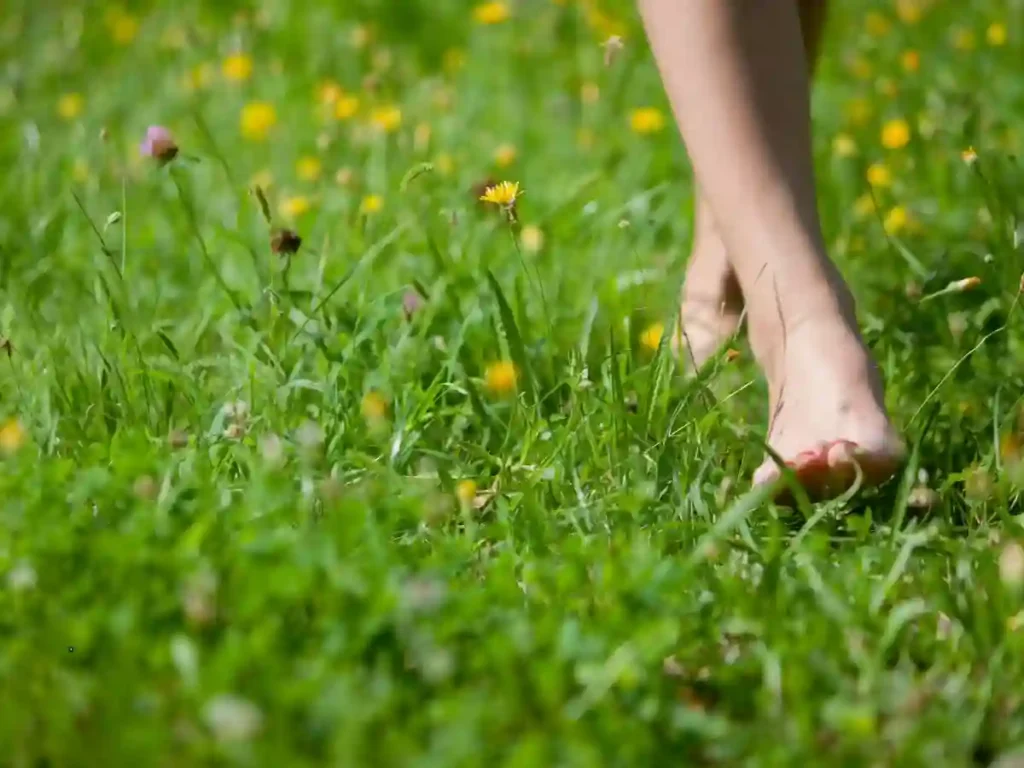Walking barefoot strengthens foot muscles, enhances natural balance, and reduces stress through grounding. Start gradually on safe surfaces to enjoy these surprising health benefits.
WomanlyZine.com
Discover the surprising barefoot walking benefits, including stronger foot muscles, improved balance, and stress relief through grounding. This guide shows how to safely integrate barefoot walking into your wellness routine.
Walking barefoot is more than just a trend or a way to connect with nature—it’s a practice that has been backed by scientific research and offers a range of health benefits. Our feet, often overlooked and forgotten, play a crucial role in our overall well-being. In this article, we will explore the surprising advantages of going barefoot and how it can improve your health and quality of life.
Table of Contents

The Natural Way to Walk
Walking barefoot allows us to restore our natural walking pattern, also known as our gait. When we wear shoes, especially those with excessive cushioning and support, we hinder the proper use of certain muscle groups in our feet. By walking barefoot, we regain better control of our foot position when it strikes the ground, leading to improved balance, proprioception (body awareness), and body mechanics.
Strengthening the Body
Not only does walking barefoot improve our gait and body mechanics, but it also strengthens our muscles and promotes pain relief. This practice helps to maintain appropriate range of motion in our foot and ankle joints, as well as strength and stability within our muscles and ligaments. By strengthening our feet and legs, we can provide better support to the lower back region, reducing the risk of pain and injuries.
Relief from Improperly Fitting Shoes
Wearing shoes that do not fit properly can lead to foot deformities such as bunions and hammertoes. Contrary to popular belief, shoes with excessive padding and cushioning do not necessarily benefit our feet. In fact, they can weaken the muscles in our feet and calves. By going barefoot or wearing minimalist shoes, we give our feet the space they need and prevent the development of foot deformities.
The Science Behind Barefoot Walking

Walking barefoot on natural surfaces like grass, sand, or dirt has been found to have therapeutic effects on our bodies. This is due to the electrical conductivity between our bodies and the earth. Our bodies carry a slight positive charge, and when we make physical contact with the earth, we discharge excess energy. This process, known as grounding or earthing, has been shown to reduce inflammation, improve sleep, and promote overall well-being.
The Benefits of Grounding
Grounding, or making a connection with the earth through barefoot walking, has numerous benefits. It can reduce inflammation, cortisol levels (the stress hormone), and fatigue. Grounding also increases energy levels, speeds up healing, and improves mood. Additionally, it has been found to regulate the nervous system and activate the vagus nerve, which plays a crucial role in heart, lung, and digestive functions.
Practicing Barefoot Walking Safely
Before fully embracing barefoot walking, it’s important to start slowly and allow your feet and ankles to adapt to the new environment. Begin with short 15- to 20-minute sessions of walking barefoot, gradually increasing the distance and time as your feet become accustomed to the sensation. Listen to your body and ease up if you experience any new pain or discomfort.
Indoor surfaces provide a safe environment to practice barefoot walking before venturing outdoors. Once comfortable indoors, you can explore walking on outside surfaces such as turf, rubber tracks, sandy beaches, or grass. Consider using minimalist shoes as a transition phase to help your feet adjust to less structure and padding. Additionally, incorporating balance exercises and participating in activities that require barefoot movement, like yoga or martial arts, can further enhance your experience.
Embracing the Benefits of Barefoot Walking

Walking barefoot is not limited to a seasonal exercise—it can be practiced year-round for ongoing therapeutic benefits. By reconnecting with the earth and allowing your feet to be free, you can experience the healing potential of nature. The Metabolic Health Retreat at Combe Grove offers an ideal opportunity to learn more about the benefits of barefoot walking and enjoy the grounding effect of the grass beneath your feet. It’s time to kick off your shoes and embrace the happy feet that come with going barefoot.
Remember, it’s essential to consult with your doctor before making any significant changes to your exercise routine, especially if you have underlying health conditions or concerns.
Conclusion
Walking barefoot is more than just a fad—it’s a scientifically-backed practice that offers a range of health benefits. By restoring our natural walking pattern, improving body mechanics, and strengthening our feet and legs, we can enhance our overall well-being and reduce the risk of pain and injuries. Grounding or earthing through barefoot walking also provides therapeutic effects, such as reducing inflammation, stress, and pain, while improving sleep and mood. So, kick off your shoes, feel the earth beneath your feet, and embrace the happy feet that come with going barefoot.

FAQs
What are the key benefits of walking barefoot?
Walking barefoot benefits include stronger foot muscles, improved natural balance, better proprioception, and reduced stress through grounding on safe surfaces.
Is it safe to start walking barefoot every day?
Yes, but ease into it. Begin walking barefoot on grass or sand to build foot strength and balance gradually. Increase duration over time to avoid injury.
How does barefoot walking reduce stress?
Stress relief from walking barefoot comes from grounding—direct skin contact with natural surfaces—believed to calm the nervous system and improve mood.
Can barefoot walking fix foot or posture issues?
Barefoot walking strengthens foot arches and muscles, enhances proprioception, and may improve posture and reduce common foot pains over time.
What surfaces are best for walking barefoot safely?
Choose soft, clean surfaces like grass, sandy beaches, natural trails, or smooth wood floors. Avoid rough concrete, sharp objects, or hot pavement.




